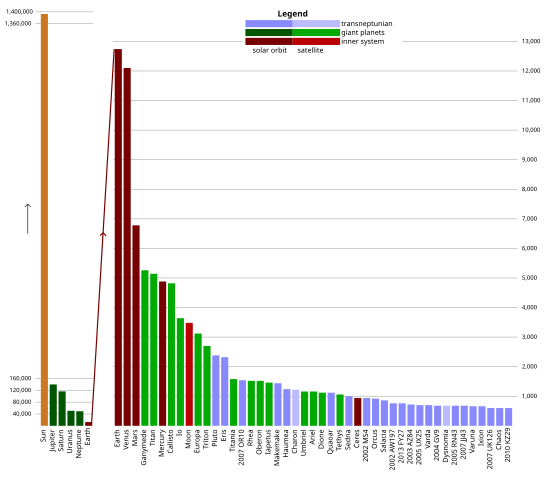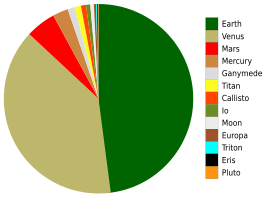List of Solar System objects by size
 |
| Objects |
|---|
| Lists |
| Planets |
|
|
This is a partial list of Solar System objects by size, arranged in descending order of mean volumetric radius, and divided into several size classes. These lists can also be sorted according to an object's mass and, for the largest objects, volume, density and surface gravity, insofar as these values are available.
This list contains the Sun, the planets, dwarf planets, many of the larger small Solar System bodies (which includes the asteroids), all named natural satellites, and a number of smaller objects of historical or scientific interest, such as comets and near-Earth objects.
Objects on this list are ordered by mean radius rather than mass; thus, objects on the lower portions of the table can be more massive than objects higher on the list if they have a higher density.
Many trans-Neptunian objects (TNOs) have been discovered; in many cases their positions in this list are approximate, as there is frequently a large uncertainty in their estimated diameters due to their distance from Earth.
Solar System objects more massive than 1021 kilograms (one yottagram [Yg]) are known or expected to be approximately spherical. Astronomical bodies relax into rounded shapes (spheroids), achieving hydrostatic equilibrium, when their own gravity is sufficient to overcome the structural strength of their material. It was believed that the cutoff for round objects is somewhere between 100 km and 200 km in radius if they have a large amount of ice in their makeup;[1] however, later studies revealed that icy satellites as large as Iapetus (1,470 kilometers in diameter) are not in hydrostatic equilibrium at this time,[2] and a 2019 assessment suggests that many TNOs in the size range of 400–1000 kilometers may not even be fully solid bodies, much less gravitationally rounded.[3] Objects that are ellipsoids due to their own gravity are here generally referred to as being "round", whether or not they are actually in equilibrium today, while objects that are clearly not ellipsoidal are referred to as being "irregular".
Spheroidal bodies typically have some polar flattening due to the centrifugal force from their rotation, and can sometimes even have quite different equatorial diameters (scalene ellipsoids such as Haumea). Unlike bodies such as Haumea, the irregular bodies have a significantly non-ellipsoidal profile, often with sharp edges.
There can be difficulty in determining the diameter (within a factor of about 2) for typical objects beyond Saturn. (See 2060 Chiron as an example) For TNOs there is some confidence in the diameters, but for non-binary TNOs there is no real confidence in the masses/densities. Many TNOs are often just assumed to have Pluto's density of 2.0 g/cm3, but it is just as likely that they have a comet-like density of only 0.5 g/cm3.[4]
For example, if a TNO is incorrectly assumed to have a mass of 3.59×1020 kg based on a radius of 350 km with a density of 2 g/cm3 but is later discovered to have a radius of only 175 km with a density of 0.5 g/cm3, its true mass would be only 1.12×1019 kg.
The sizes and masses of many of the moons of Jupiter and Saturn are fairly well known due to numerous observations and interactions of the Galileo and Cassini orbiters; however, many of the moons with a radius less than ~100 km, such as Jupiter's Himalia, have far less certain masses.[5] Further out from Saturn, the sizes and masses of objects are less clear. There has not yet been an orbiter around Uranus or Neptune for long-term study of their moons. For the small outer irregular moons of Uranus, such as Sycorax, which were not discovered by the Voyager 2 flyby, even different NASA web pages, such as the National Space Science Data Center[6] and JPL Solar System Dynamics,[5] give somewhat contradictory size and albedo estimates depending on which research paper is being cited.
There are uncertainties in the figures for mass and radius, and irregularities in the shape and density, with accuracy often depending on how close the object is to Earth or whether it has been visited by a probe.
Graphical overview[]


Relative masses of the bodies of the Solar System. Objects smaller than Saturn are not visible at this scale.
List of objects by mean radius[]
Larger than 400 km[]
It was once expected that any icy body larger than approximately 200 km in radius was likely to be in hydrostatic equilibrium (HE).[7] However, Ceres (r = 470 km) is the smallest body for which detailed measurements are consistent with hydrostatic equilibrium,[8] whereas Iapetus (r = 735 km) is the largest icy body that has been found to not be in hydrostatic equilibrium.[9] The known icy moons in this range are all ellipsoidal (except Proteus), but trans-Neptunian objects up to 450–500 km radius may be quite porous.[10]
For simplicity and comparative purposes, the values are manually calculated assuming that the bodies are all perfect spheres. The size of solid bodies does not include an object's atmosphere. For example, Titan looks bigger than Ganymede, but its solid body is smaller. For the giant planets, the "radius" is defined as the distance from the center at which the atmosphere reaches 1 bar of atmospheric pressure.[11]
| Body[note 1] | Image | Radius[note 2] | Volume | Mass | Surface Area | Density | Gravity[note 3] | Type | # (R/M) [note 4] |
Discovery | |||||
|---|---|---|---|---|---|---|---|---|---|---|---|---|---|---|---|
| (km) | (R | ||||||||||||||



